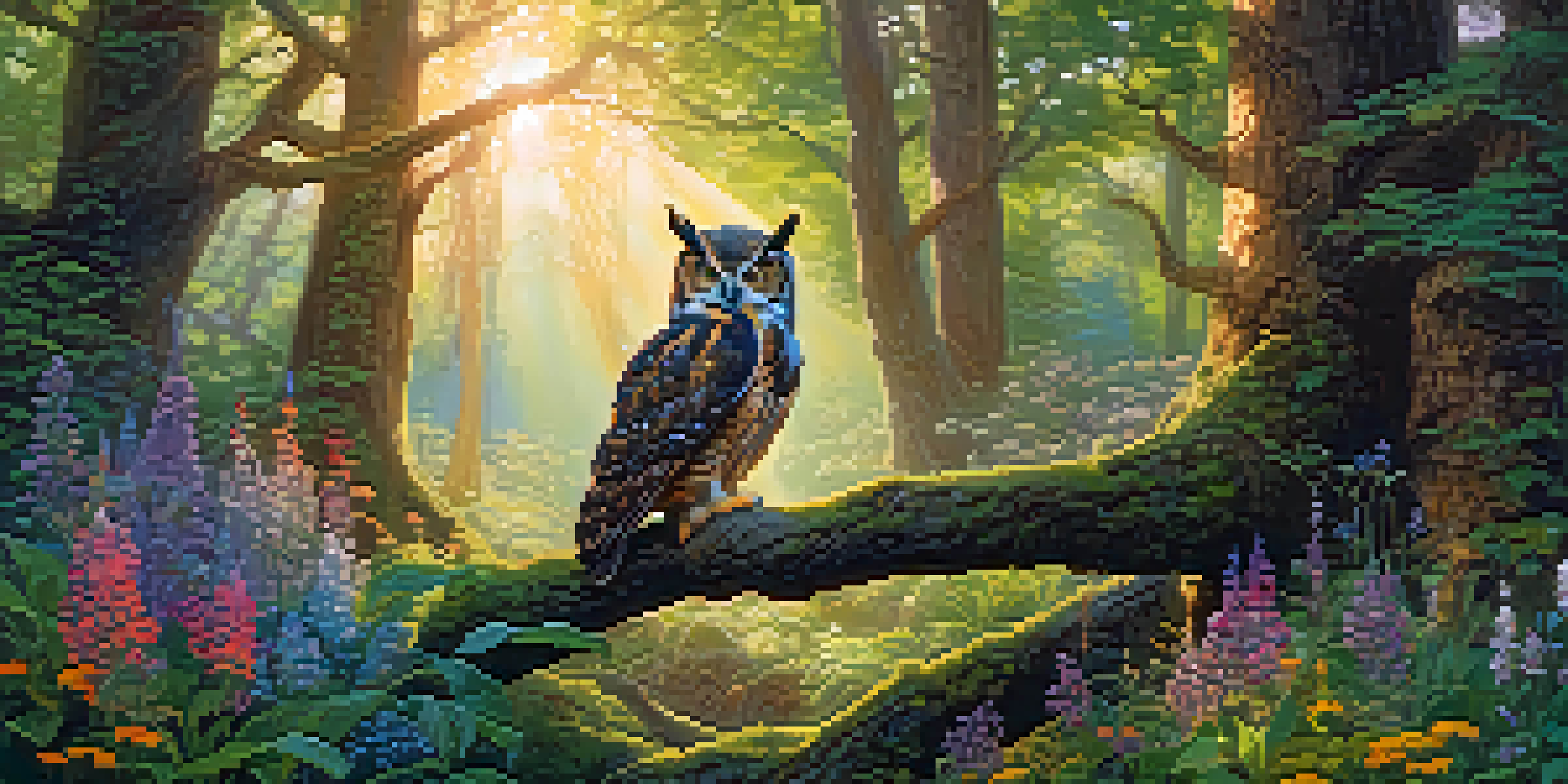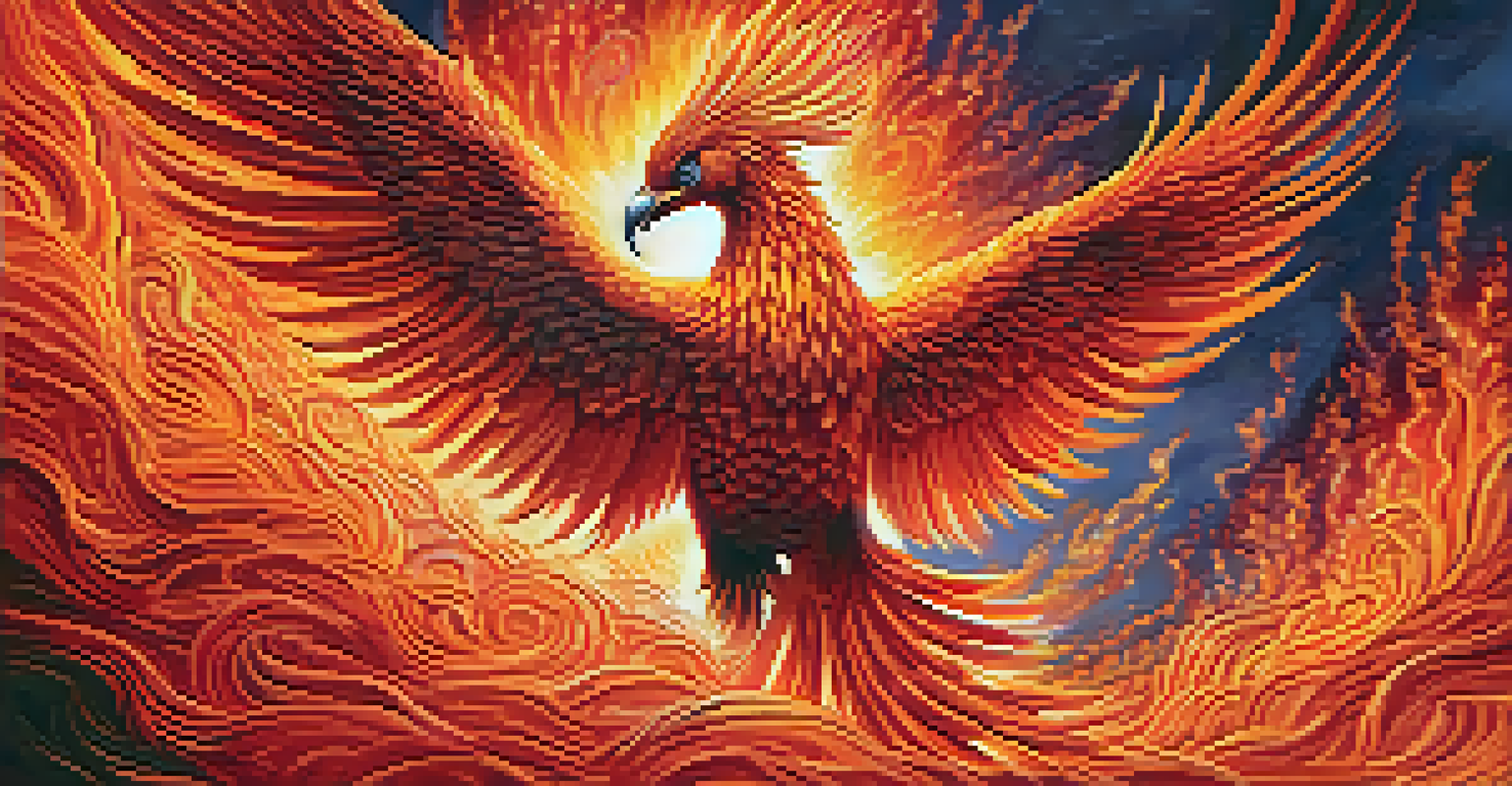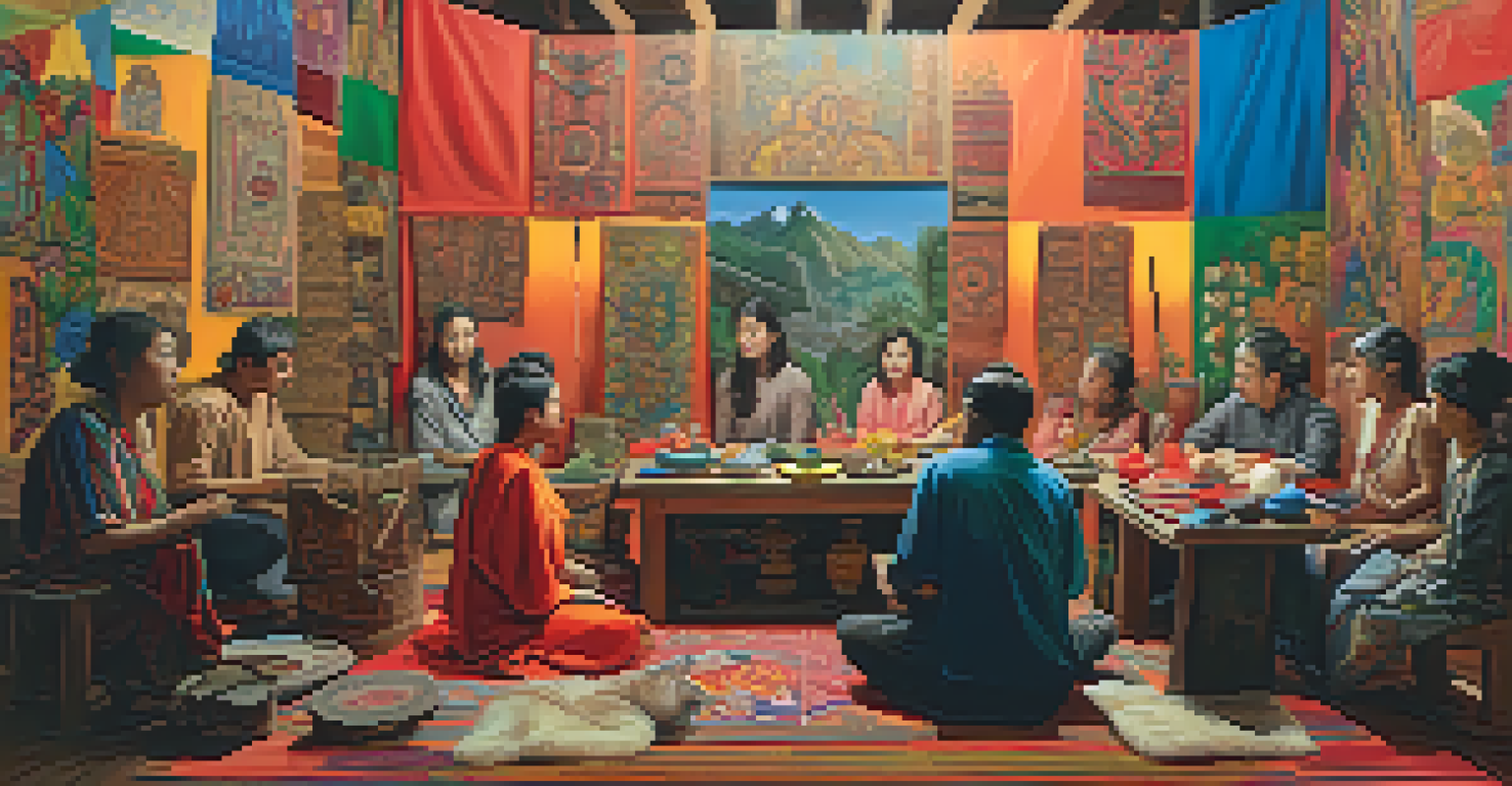The Role of Folklore in Shaping Artistic Mythological Themes

Understanding Folklore and Its Cultural Significance
Folklore encompasses the traditions, stories, and practices passed down through generations, often reflecting the values and beliefs of a community. It serves as a cultural repository, preserving the unique narratives that shape our understanding of the world. By studying folklore, we can appreciate the rich tapestry of human experience and the ways it informs our creative expressions.
Folklore is the most important part of a society's culture, encompassing the traditions, stories, and practices that define a community.
These stories often involve supernatural elements, moral lessons, or explanations for natural phenomena, making them relatable and engaging. They are not just tales; they are the backbone of cultural identity, offering insights into societal norms and historical contexts. This cultural significance makes folklore a vital resource for artists seeking to explore deeper mythological themes.
As artists draw from folklore, they create works that resonate with audiences on multiple levels, often tapping into shared human experiences. The intertwining of folklore with art allows for a dialogue between the past and present, enriching both fields. This connection is where folklore's role in shaping artistic mythological themes truly begins.
The Interplay Between Folklore and Myths
Myths and folklore often coexist, with each influencing the other in profound ways. While myths are typically grand narratives that explain the universe's origins or fundamental truths, folklore comprises the everyday stories that reflect cultural nuances. This interplay allows artists to blend the epic with the personal, crafting narratives that resonate with broader themes while remaining grounded in local traditions.

For instance, many mythological figures are adapted from folklore, evolving over time into icons of cultural significance. This transformation can be seen in how characters like Hercules or Thor have been reinterpreted in various artistic forms, including literature, film, and visual arts. By weaving these elements together, artists create a rich, layered understanding of mythology that speaks to contemporary audiences.
Folklore Preserves Cultural Identity
Folklore serves as a cultural repository, reflecting the values and beliefs of communities while shaping artistic expressions.
Moreover, the stories that emerge from this synthesis often challenge traditional narratives, offering alternative perspectives that highlight underrepresented voices. This dynamic not only enriches the artistic landscape but also invites viewers to question their understanding of mythology and its relevance in today's society.
Artistic Expression: A Reflection of Folklore
Artists have long looked to folklore for inspiration, using its themes and characters to explore complex human emotions and societal issues. Through various mediums—be it painting, sculpture, or digital art—creatives reinterpret these age-old stories, breathing new life into them. This artistic expression serves as a mirror, reflecting the cultural and emotional landscapes of both the artist and the audience.
Art is the most beautiful of all lies; it is the lie that tells the truth about the human experience.
For example, the use of folklore in modern animation or graphic novels often brings forth colorful adaptations of traditional tales, making them accessible and engaging for younger generations. This approach not only preserves the stories but also revitalizes them, ensuring their survival in a rapidly changing world. As a result, folklore becomes a canvas for contemporary issues, allowing for a dialogue about identity, values, and collective memory.
Thus, the role of folklore in artistic expression is not merely about replication; it's about transformation and adaptation. Artists take these foundational stories and reinterpret them through their unique lenses, creating works that resonate on personal and communal levels. This ongoing relationship between folklore and art continues to shape the mythical narratives we cherish today.
The Symbolism of Folklore in Mythological Art
Symbolism plays a crucial role in the ways folklore is represented in mythological art. Artists often incorporate symbols derived from folklore to convey deeper meanings, linking the visual experience to cultural narratives. For instance, the use of specific colors, animals, or motifs can evoke particular emotions or ideas, enriching the viewer's understanding of the piece.
Take the image of the phoenix, for instance, which is frequently found in various folklore traditions as a symbol of rebirth and renewal. When artists depict this creature, they tap into a long-standing narrative that transcends cultures, allowing audiences to connect with the artwork on a more profound level. This shared symbolism fosters a sense of familiarity and resonance, making the artwork more impactful.
Art Transforms Traditional Stories
Artists reinterpret folklore through various mediums, revitalizing age-old stories to address contemporary issues and engage new audiences.
Moreover, the use of folklore-inspired symbolism encourages viewers to explore the underlying stories and meanings behind the artwork. This exploration can lead to a deeper appreciation of both the art and the cultural heritage it represents, creating a bridge between the past and the present that enriches the overall artistic experience.
Folklore's Influence on Modern Mythological Narratives
In contemporary storytelling, folklore continues to shape modern mythological narratives, influencing everything from literature to film. Writers and filmmakers often draw upon these traditional tales to craft narratives that explore timeless themes such as heroism, love, and morality. This blending of old and new creates stories that feel both familiar and fresh, appealing to diverse audiences.
For instance, the resurgence of fairy tales in popular media showcases how folklore can be reimagined to reflect modern sensibilities. By taking classic tales and infusing them with contemporary issues, creators can engage viewers in meaningful conversations about societal values and challenges. This evolution highlights the versatility of folklore as a source of inspiration, proving its relevance in today's artistic landscape.
Furthermore, the incorporation of folklore into modern narratives often leads to a reexamination of cultural identity and heritage. As artists and storytellers weave these elements into their works, they invite audiences to reflect on their own backgrounds and experiences, fostering a deeper understanding of the interconnectedness of human stories across time and space.
The Role of Folklore in Cross-Cultural Artistic Exchange
Folklore serves as a bridge for cross-cultural artistic exchange, allowing artists from different backgrounds to share and reinterpret stories. As globalization increases, the blending of diverse folklore traditions leads to new artistic expressions that celebrate cultural diversity. This exchange not only enriches the artistic community but also fosters mutual understanding and respect among different cultures.
For example, the fusion of African folklore with Western artistic styles has given rise to unique visual art forms, music, and literature that highlight shared human experiences. This collaboration illustrates how folklore can transcend geographical boundaries, allowing artists to explore themes that resonate universally. As a result, the dialogue between cultures can lead to innovative and exciting artistic works.
Folklore Fosters Cross-Cultural Exchange
The blending of diverse folklore traditions encourages mutual understanding and respect, enriching the artistic landscape globally.
Moreover, these cross-cultural exchanges often challenge stereotypes and promote inclusivity by showcasing the richness of different traditions. By embracing folklore from various cultures, artists create a more holistic view of humanity, emphasizing the interconnectedness of our stories. This dynamic not only enhances the artistic landscape but also contributes to a more empathetic and understanding global society.
Future Directions: Folklore and Mythology in Art
As we look to the future, the role of folklore in shaping artistic mythological themes is likely to evolve further. Emerging technologies, such as virtual reality and interactive installations, offer new avenues for artists to explore and reinterpret traditional narratives. This technological integration can amplify the emotional resonance of folklore, creating immersive experiences that engage audiences in unprecedented ways.
Additionally, there is a growing movement towards inclusivity and representation in the arts, encouraging artists to draw from underrepresented folklore traditions. This shift not only broadens the scope of artistic expression but also allows for a richer tapestry of stories to be told, reflecting the diverse experiences of our world. As these voices emerge, they will undoubtedly influence the future of mythological art.

Ultimately, the relationship between folklore and art is one of continual growth and transformation. As artists embrace new mediums and perspectives, the stories that shape our understanding of mythology will continue to evolve, ensuring that folklore remains a vital source of inspiration for generations to come.